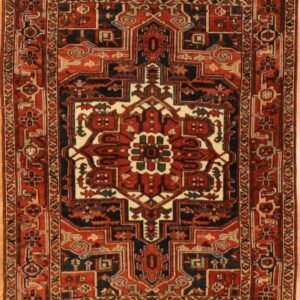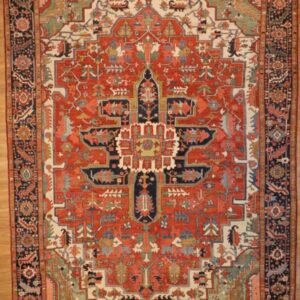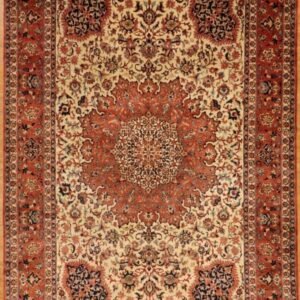Serial No.: 0009816
Origin: Caucasian, Azerbaijan
Town: Chichi Shirvan
Age: Late 19th Century
Style: Tribal Geometric
Size: 4′ x 6’5″
Material: Wool pile and wool foundation, vegetable dyed
Color Scheme: Red, Navy, Ivory, Gold
Condition: Excellent
Expert Description
This late 19th-century Chichi Shirvan rug stands out as a quintessential example of Caucasian weaving artistry, renowned for its compact geometric motifs and vivid color contrasts. The field is predominantly red, punctuated by an allover arrangement of stylized rosettes and small, angular elements. The complementary navy, ivory, and gold hues emerge from natural dyes, creating a harmonious interplay that highlights each individual motif against the richly hued background.
Weaving Techniques & Materials
Woven on a wool foundation with a wool pile, the rug employs the symmetrical (Turkish) knot—a hallmark of Caucasian weaving—enabling the precise articulation of the rosettes and surrounding geometric details. The dyes are derived from locally available sources, such as madder root for red and indigo for navy, yielding vibrant yet enduring colors. This natural dyeing process often produces subtle tonal variations (abrash), which enhance the rug’s depth and authenticity.
Why It Is Called “Chichi”
The term “Chichi” originates from a village in the Shirvan region that historically specialized in producing rugs with small-scale, repeating patterns, often featuring floral rosettes and lattice-like layouts. Over time, the distinctive style gained recognition beyond the village itself, and the name “Chichi” became associated with any Shirvan rug displaying these characteristic design elements—namely an allover field of compact rosettes, balanced borders, and a bright, contrasting palette. Although originally linked to a specific locale, the style’s popularity led to widespread adoption by neighboring weavers, cementing the “Chichi” label as a signature of this intricate, rosette-driven design.
Cultural & Historical Context
Situated in the eastern Caucasus, Shirvan was a flourishing center of textile production throughout the 19th century. Family-run workshops were common, with weaving techniques passed down through generations. The motifs found in Chichi rugs—such as rosettes, crosses, and stylized foliage—often carried cultural significance, symbolizing protection, fertility, or communal identity. These visual codes linked individual weavers to a broader cultural tapestry, where shared beliefs and stories were preserved in every knot.
Artistic Significance
Maintained in excellent condition, this rug not only showcases the technical prowess of Chichi Shirvan weavers but also offers insight into the social and artistic heritage of the Caucasus. Its vivid color scheme, meticulous design, and resilient wool construction exemplify the enduring appeal of late 19th-century tribal rugs. Collectors and scholars prize such pieces for their harmonious blend of form and function, where aesthetics meet cultural storytelling. As a testament to Shirvan’s legacy, this Chichi rug remains a captivating artifact of Azerbaijan’s weaving tradition, bridging the past and present through its timeless beauty and craftsmanship.







Reviews
There are no reviews yet.